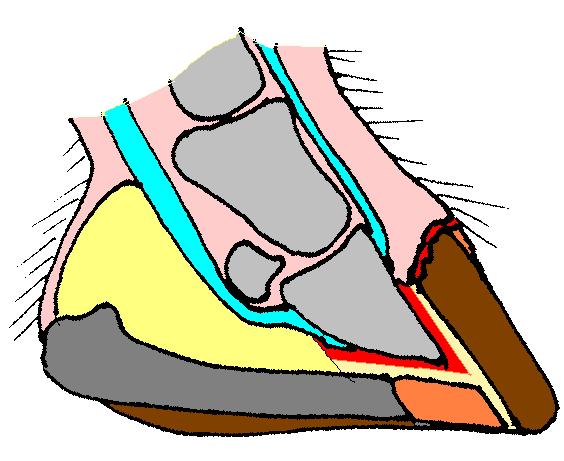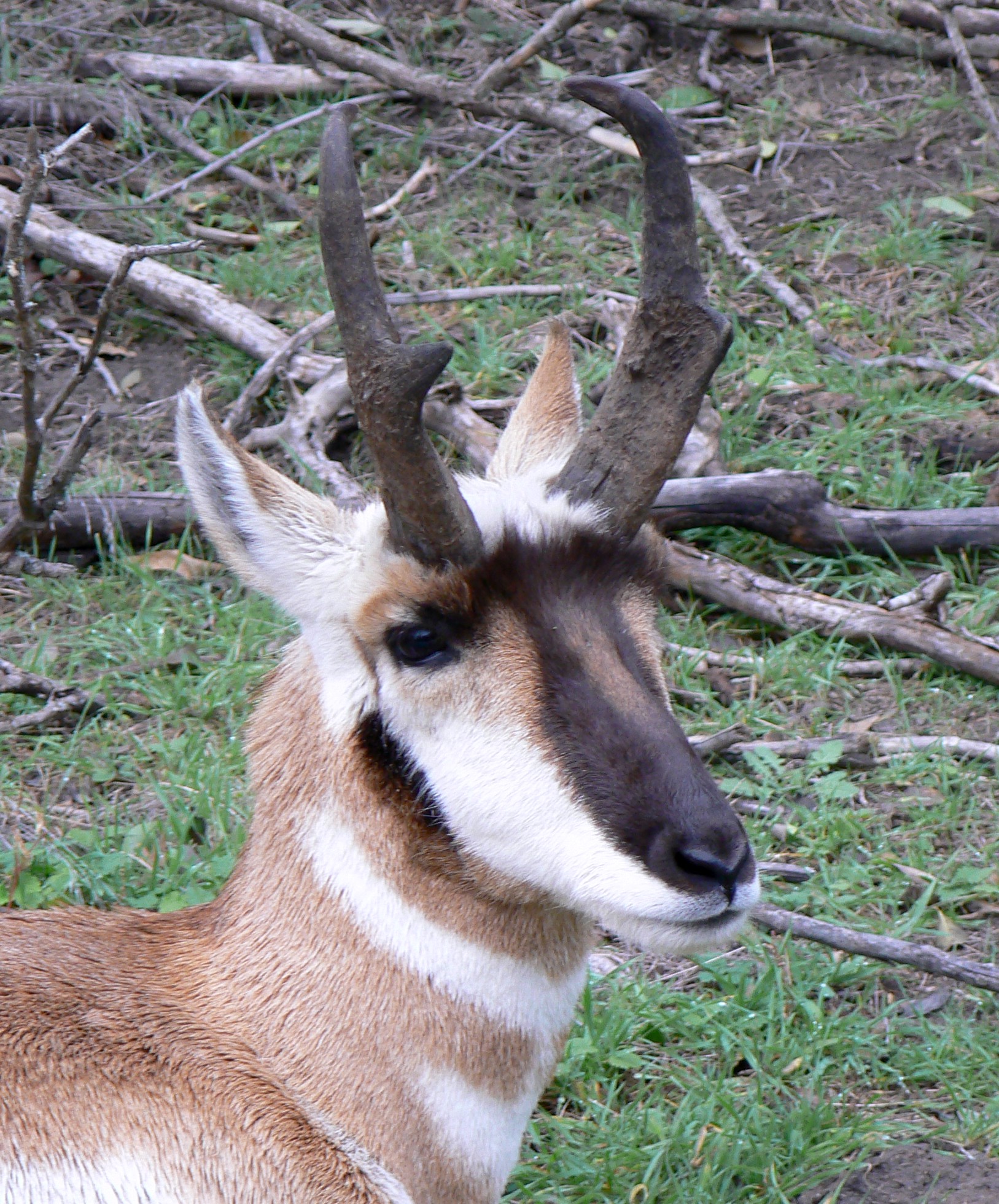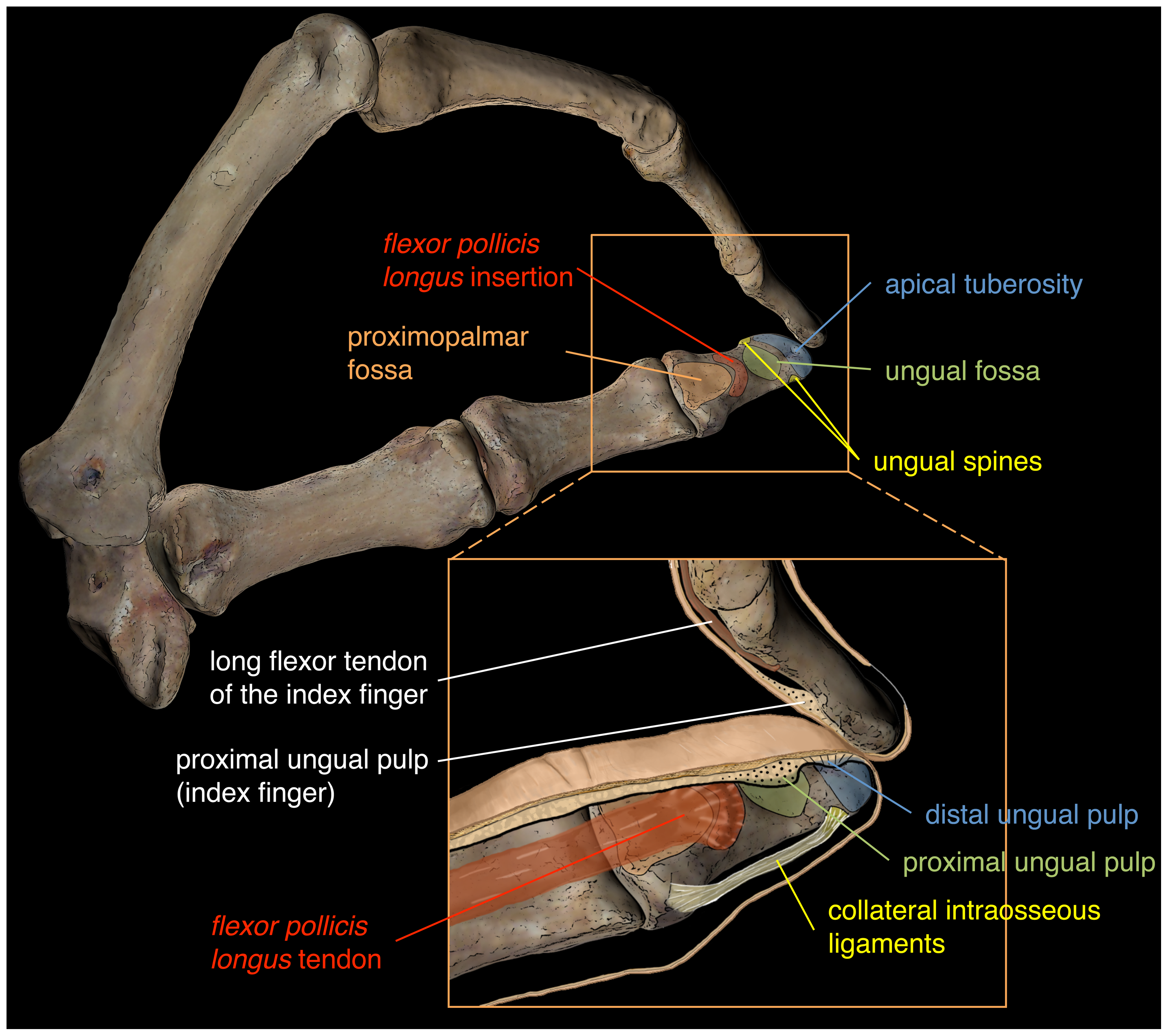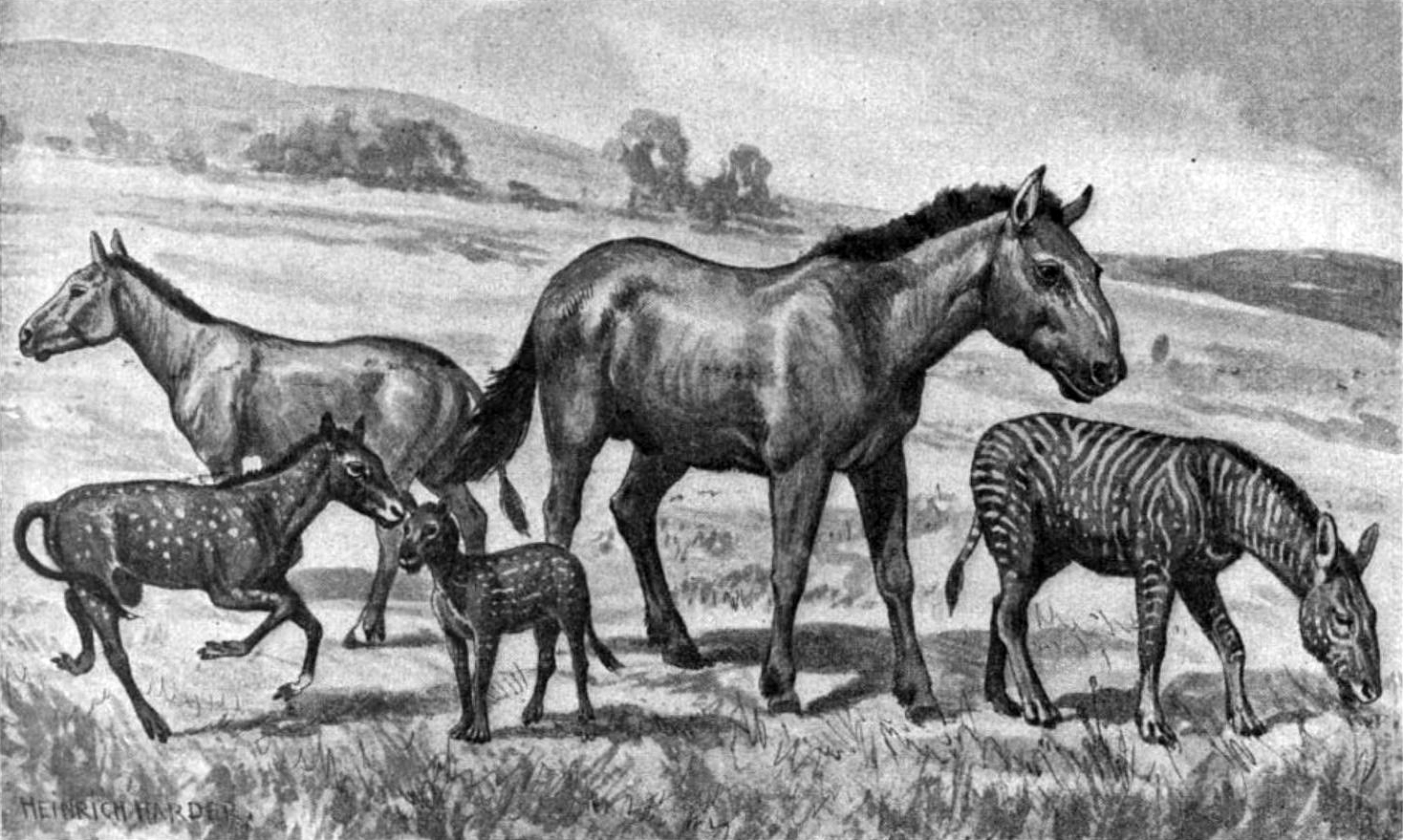|
Hoofed
The hoof (plural: hooves) is the tip of a toe of an ungulate mammal, which is covered and strengthened with a thick and horny keratin covering. Artiodactyls are even-toed ungulates, species whose feet have an even number of digits, yet the ruminants with two digits, are the most numerous, e.g. giraffe, deer, bison, cattle, goat, and sheep. The feet of perissodactyl mammals have an odd number of toes, e.g. the horse, the rhinoceros, and the tapir. Hooves are limb structures restricted to placental mammals, which have long pregnancies; however, the marsupial '' Chaeropus'' had hooves. Description The hoof surrounds the distal end of the second phalanx, the distal phalanx, and the navicular bone. The hoof consists of the hoof wall, the bars of the hoof, the sole and frog and soft tissue shock absorption structures. The weight of the animal is normally borne by both the sole and the edge of the hoof wall. Hooves perform many functions, including supporting the we ... [...More Info...] [...Related Items...] OR: [Wikipedia] [Google] [Baidu] |
Ungulate
Ungulates ( ) are members of the diverse clade Ungulata which primarily consists of large mammals with hooves. These include odd-toed ungulates such as horses, rhinoceroses, and tapirs; and even-toed ungulates such as cattle, pigs, giraffes, camels, sheep, deer, and hippopotamuses. Cetaceans such as whales, dolphins, and porpoises are also classified as even-toed ungulates, although they do not have hooves. Most terrestrial ungulates use the hoofed tips of their toes to support their body weight while standing or moving. The term means, roughly, "being hoofed" or "hoofed animal". As a descriptive term, "ungulate" normally excludes cetaceans as they do not possess most of the typical morphological characteristics of other ungulates, but recent discoveries indicate that they were also descended from early artiodactyls. Ungulates are typically herbivorous and many employ specialized gut bacteria to allow them to digest cellulose. Some modern species, such as pigs, are omnivorous, ... [...More Info...] [...Related Items...] OR: [Wikipedia] [Google] [Baidu] |
Even-toed Ungulate
The even-toed ungulates (Artiodactyla , ) are ungulates—hoofed animals—which bear weight equally on two (an even number) of their five toes: the third and fourth. The other three toes are either present, absent, vestigial, or pointing posteriorly. By contrast, odd-toed ungulates bear weight on an odd number of the five toes. Another difference between the two is that many other even-toed ungulates (with the exception of Suina) digest plant cellulose in one or more stomach chambers rather than in their intestine as the odd-toed ungulates do. Cetaceans (whales, dolphins, and porpoises) evolved from even-toed ungulates, and are therefore often classified under the same taxonomic branch because a species cannot outgrow its evolutionary ancestry; some modern taxonomists combine the two under the name Cetartiodactyla , while others opt to include cetaceans in the already-existing Artiodactyla. The roughly 270 land-based even-toed ungulate species include pigs, peccaries, hippo ... [...More Info...] [...Related Items...] OR: [Wikipedia] [Google] [Baidu] |
Artiodactyl
The even-toed ungulates (Artiodactyla , ) are ungulates—hoofed animals—which bear weight equally on two (an even number) of their five toes: the third and fourth. The other three toes are either present, absent, vestigial, or pointing posteriorly. By contrast, odd-toed ungulates bear weight on an odd number of the five toes. Another difference between the two is that many other even-toed ungulates (with the exception of Suina) digest plant cellulose in one or more stomach chambers rather than in their intestine as the odd-toed ungulates do. Cetaceans (whales, dolphins, and porpoises) evolved from even-toed ungulates, and are therefore often classified under the same taxonomic branch because a species cannot outgrow its evolutionary ancestry; some modern taxonomists combine the two under the name Cetartiodactyla , while others opt to include cetaceans in the already-existing Artiodactyla. The roughly 270 land-based even-toed ungulate species include pigs, peccaries, hippopota ... [...More Info...] [...Related Items...] OR: [Wikipedia] [Google] [Baidu] |
Pronghorn
The pronghorn (, ) (''Antilocapra americana'') is a species of artiodactyl (even-toed, hoofed) mammal indigenous to interior western and central North America. Though not an antelope, it is known colloquially in North America as the American antelope, prong buck, pronghorn antelope and prairie antelope, because it closely resembles the antelopes of the Old World and fills a similar ecological niche due to parallel evolution. It is the only surviving member of the family Antilocapridae. During the Pleistocene epoch, about 11 other antilocaprid species existed in North America.Smithsonian Institution. North American MammalsPronghorn ''Antilocapra americana''/ref> Three other genera (''Capromeryx'', '' Stockoceros'' and ''Tetrameryx'') existed when humans entered North America but are now extinct. As a member of the superfamily Giraffoidea, the pronghorn's closest living relatives are the giraffe and okapi. See Fig. S10 in Supplementary Information. The Giraffoidea are in tu ... [...More Info...] [...Related Items...] OR: [Wikipedia] [Google] [Baidu] |
Phalanx Bone
The phalanges (singular: ''phalanx'' ) are digital bones in the hands and feet of most vertebrates. In primates, the thumbs and big toes have two phalanges while the other digits have three phalanges. The phalanges are classed as long bones. Structure The phalanges are the bones that make up the fingers of the hand and the toes of the foot. There are 56 phalanges in the human body, with fourteen on each hand and foot. Three phalanges are present on each finger and toe, with the exception of the thumb and large toe, which possess only two. The middle and far phalanges of the fifth toes are often fused together (symphalangism). The phalanges of the hand are commonly known as the finger bones. The phalanges of the foot differ from the hand in that they are often shorter and more compressed, especially in the proximal phalanges, those closest to the torso. A phalanx is named according to whether it is proximal, middle, or distal and its associated finger or toe. The proximal ... [...More Info...] [...Related Items...] OR: [Wikipedia] [Google] [Baidu] |
Distal Phalanx
The phalanges (singular: ''phalanx'' ) are digital bones in the hands and feet of most vertebrates. In primates, the thumbs and big toes have two phalanges while the other digits have three phalanges. The phalanges are classed as long bones. Structure The phalanges are the bones that make up the fingers of the hand and the toes of the foot. There are 56 phalanges in the human body, with fourteen on each hand and foot. Three phalanges are present on each finger and toe, with the exception of the thumb and large toe, which possess only two. The middle and far phalanges of the fifth toes are often fused together (symphalangism). The phalanges of the hand are commonly known as the finger bones. The phalanges of the foot differ from the hand in that they are often shorter and more compressed, especially in the proximal phalanges, those closest to the torso. A phalanx is named according to whether it is proximal, middle, or distal and its associated finger or toe. The proximal ... [...More Info...] [...Related Items...] OR: [Wikipedia] [Google] [Baidu] |
Horse
The horse (''Equus ferus caballus'') is a domesticated, one-toed, hoofed mammal. It belongs to the taxonomic family Equidae and is one of two extant subspecies of ''Equus ferus''. The horse has evolved over the past 45 to 55 million years from a small multi-toed creature, ''Eohippus'', into the large, single-toed animal of today. Humans began domesticating horses around 4000 BCE, and their domestication is believed to have been widespread by 3000 BCE. Horses in the subspecies ''caballus'' are domesticated, although some domesticated populations live in the wild as feral horses. These feral populations are not true wild horses, as this term is used to describe horses that have never been domesticated. There is an extensive, specialized vocabulary used to describe equine-related concepts, covering everything from anatomy to life stages, size, colors, markings, breeds, locomotion, and behavior. Horses are adapted to run, allowing them to quickly escape predators, and po ... [...More Info...] [...Related Items...] OR: [Wikipedia] [Google] [Baidu] |
Perissodactyl
Odd-toed ungulates, mammals which constitute the taxonomic order Perissodactyla (, ), are animals—ungulates—who have reduced the weight-bearing toes to three (rhinoceroses and tapirs, with tapirs still using four toes on the front legs) or one (equines, third toe) of the five original toes. The non-weight-bearing toes are either present, absent, vestigial, or positioned posteriorly. By contrast, the even-toed ungulates bear most of their weight equally on four or two (an even number) of the five toes: their third and fourth toes. Another difference between the two is that odd-toed ungulates digest plant cellulose in their intestines rather than in one or more stomach chambers as even-toed ungulates, with the exception of Suina, do. The order includes about 17 species divided into three families: Equidae (horses, asses, and zebras), Rhinocerotidae (rhinoceroses), and Tapiridae (tapirs). Despite their very different appearances, they were recognized as related families in ... [...More Info...] [...Related Items...] OR: [Wikipedia] [Google] [Baidu] |
Equidae
Equidae (sometimes known as the horse family) is the taxonomic family of horses and related animals, including the extant horses, asses, and zebras, and many other species known only from fossils. All extant species are in the genus '' Equus'', which originated in North America. Equidae belongs to the order Perissodactyla, which includes the extant tapirs and rhinoceros, and several extinct families. The term equid refers to any member of this family, including any equine. Evolution The oldest known fossils assigned to Equidae were found in North America, and date from the early Eocene epoch, 54 million years ago. They were once assigned to the genus ''Hyracotherium'', but the type species of that genus is now regarded as a palaeothere. The other species have been split off into different genera. These early equids were fox-sized animals with three toes on the hind feet, and four on the front feet. They were herbivorous browsers on relatively soft plants, and already adapte ... [...More Info...] [...Related Items...] OR: [Wikipedia] [Google] [Baidu] |
Dewclaw
A dewclaw is a digit – vestigial in some animals – on the foot of many mammals, birds, and reptiles (including some extinct orders, like certain theropods). It commonly grows higher on the leg than the rest of the foot, such that in digitigrade or unguligrade species it does not make contact with the ground when the animal is standing. The name refers to the dewclaw's alleged tendency to brush dew away from the grass.Danziger, D., & McCrum, M. (2008). ''The Thingummy: A book about those everyday objects you just can't name''. London: Doubleday. On dogs and cats the dewclaws are on the inside of the front legs, similarly to a human's thumb, which shares evolutionary homology. Although many animals have dewclaws, other similar species do not, such as horses, giraffes and the African wild dog. Dogs Dogs almost always have dewclaws on the inside of the front legs and occasionally also on the hind legs. Unlike front dewclaws, rear dewclaws tend to have little bone or muscle s ... [...More Info...] [...Related Items...] OR: [Wikipedia] [Google] [Baidu] |
Giraffe
The giraffe is a large African hoofed mammal belonging to the genus ''Giraffa''. It is the tallest living terrestrial animal and the largest ruminant on Earth. Traditionally, giraffes were thought to be one species, ''Giraffa camelopardalis'', with nine subspecies. Most recently, researchers proposed dividing them into up to eight extant species due to new research into their mitochondrial and nuclear DNA, as well as morphological measurements. Seven other extinct species of ''Giraffa'' are known from the fossil record. The giraffe's chief distinguishing characteristics are its extremely long neck and legs, its horn-like ossicones, and its spotted coat patterns. It is classified under the family Giraffidae, along with its closest extant relative, the okapi. Its scattered range extends from Chad in the north to South Africa in the south, and from Niger in the west to Somalia in the east. Giraffes usually inhabit savannahs and woodlands. Their food source is leaves, frui ... [...More Info...] [...Related Items...] OR: [Wikipedia] [Google] [Baidu] |
Camel
A camel (from: la, camelus and grc-gre, κάμηλος (''kamēlos'') from Hebrew or Phoenician: גָמָל ''gāmāl''.) is an even-toed ungulate in the genus ''Camelus'' that bears distinctive fatty deposits known as "humps" on its back. Camels have long been domesticated and, as livestock, they provide food (milk and meat) and textiles (fiber and felt from hair). Camels are working animals especially suited to their desert habitat and are a vital means of transport for passengers and cargo. There are three surviving species of camel. The one-humped dromedary makes up 94% of the world's camel population, and the two-humped Bactrian camel makes up 6%. The Wild Bactrian camel is a separate species and is now critically endangered. The word ''camel'' is also used informally in a wider sense, where the more correct term is "camelid", to include all seven species of the family Camelidae: the true camels (the above three species), along with the "New World" camelids: the llama, ... [...More Info...] [...Related Items...] OR: [Wikipedia] [Google] [Baidu] |










